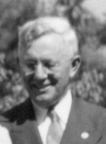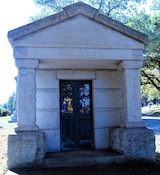The Log of “Jason” Glasscock
|  Jan 1878 - Apr 1965 |
The Log of “Jason” Glasscock
|  Jan 1878 - Apr 1965 |
I have lain on the bed off and on most of the day trying to induce my “porely” feelings to leave me. About noon, however, I thought it would do me good to drive through Rock Creek Park. If you lay a ruler on the map and measure from the most northern end of the Park down through Zoological Park and the southern extension to the Potomac, which is called Rock Creek and Potomac Parkway, the distance is six miles. But you know an angle worm is much longer stretched out than if you measure it from head to tail straight across his wiggles. So with the roads through this Park. The speedometer might say it is ten miles from end to end of the road. Down the center runs Rock Creek. It would be a good-sized river in California. The driver told me that while immediately following a storm there will be more water than normal, the flow remains about the same the year round because it is fed from springs in the hills and in the Blue Ridge Mountains. When we got to the upper end of the Park I noticed several rivulets running out of grassy places and headed for the main creek. To these grassy, spongy places the wild blackberries and raspberries were coming into leaf. All through the park the white and pink dogwood were just coming into full bloom, and the red bud too. The driver called the red bud the “Judas Tree, sometimes called red bud.” I was especially interested in the pink dogwood. Seems to me the Arrowhead Lake Company would do a nice bit of work to get some of these pink blossomed dogwoods started on the San Bernardino Mountains. Perhaps the Rim of the World Club should do it. I must suggest this to Sandy Sanborn and Charley Mann.
It is rather difficult to give a word picture of the Park as a whole. The stream dominates it, of course. The trees and the flowers are native. Much of the ground had been cleaned up, it is true, but in the north end it is “natural” and real “woodsy.” The trees were just leafing out, and are not as well leafed as the street trees in the city. The day was real warm, the official high temperature of the day at 2:00 PM being 91°, so the air was delicious and Spring-like. I relaxed in the back seat of the car and let the driver tell me about things and asked him some questions. He was very enthusiastic about the pink dogwood and called nearly every clump to my attention with a “Just look at that!”
There were picnic parties here and there, and young people playing “catch.” Young couples of the tennis age were sitting on rocks by the stream and letting their feet dangle over and talking and laughing. There were a good many people on horseback. It seemed to me that the young folk sitting on the rocks were having the most fun -- no trouble to dress especially, just leave the necktie at home and sit next to her instead of having her on a separate horse in front of you.
The driver wanted me to see the Walter Reed Hospital grounds because he admired them so much. There are new portions not yet planted, but the older area is beautiful, but in a more formal way than Rock Creek Park. Both kinds have their place, of course, but today I enjoyed the Creek Park the better. It was at this hospital that President Coolidge’s son died from sceptcemia [sic]. [Septicemia: bacterial blood poisoning.] My driver told me it seems to be a scourge about here for he lost his mother-in-law, and wife, and twenty-one-year-old daughter from the same disease. This institution is devoted exclusively to government employees and their families. [Read about the Grace Anna (Goodhue) Coolidge, First Lady from 1923 to 1928.]
We went on to the National Soldiers’ Home. The driver told me General Winfield Scott started the Home many years ago and that it is self-supporting. The financing was begun and carried on by a deduction of twenty-five cents per month from the pay of every Union soldier and Spanish War soldier. These are the only two groups of soldiers here, according to my guide. Only a few Civil War veterans are left. There is a wonderful herd of Holstein milk cows here, and chickens by the thousands. Two hundred ten dozen [210 dozen, or 2,520] eggs are used for breakfast on Friday mornings. Seems to me that is some eggs.
On the way back I noted rows of two-story apartments spread over a large area. In fact, it is characteristic of residential construction in the whole eastern country that I have seen that houses are set on narrow lots with very little or no air space between. Of course, I am speaking of the cities. Well, you think of the long chicken colony houses in California. But people live in them, and the white collar folks pay from $50 to $75 per month rent, and some even try to buy them -- I mean a single section out of the whole string. Even the very rich have small yards, although their house may be large.
So I came back to the hotel and rested again, and pondered my situation here. I put my mind to work on answering the question of how I could with appropriateness and “finesse” make use of Mr. Shoup’s offer to help.
I must not forget to mention a very interesting piece of bronze statuary which my driver insisted on showing me in Rock Creek Cemetery. This is the old cemetery, and does not appear to be any too well kept. It would not go over in California. We got out of the car and walked down to a clump of shrubs and went inside. There, against a wall, sits a bronze figure of a woman wrapped in a mantle, the face showing a hurt, sad expression. The story which my driver told me was that the woman buried there was the wife of a gambler. The husband would sometimes stay away over a night, but not very often. But one time he stayed away three nights. When he returned he found his wife sitting, just as the figure sits there, with that pained, sad expression, dead. He hired the great sculptor, Borglum, to do this statue. One has to know about it to find it. My driver thinks it will be famous some day, probably after Borglum is dead.

My driver pointed out a vault with a stained glass window on one end. He said the caskets of both the husband and wife are in there now, but after the wife died he used often to drive the husband out on Sundays. The man would take some musical instrument along and sit in there and play and sing old songs by the hour. His name was Elie Sheetz, the originator of the Martha Washington Candies. [There is an interesting article about Mr. Sheetz in the National Magazine, Volume 50, from 1922.]
| < May 4-5, 1934 | Table of Contents | May 7, 1934 > |